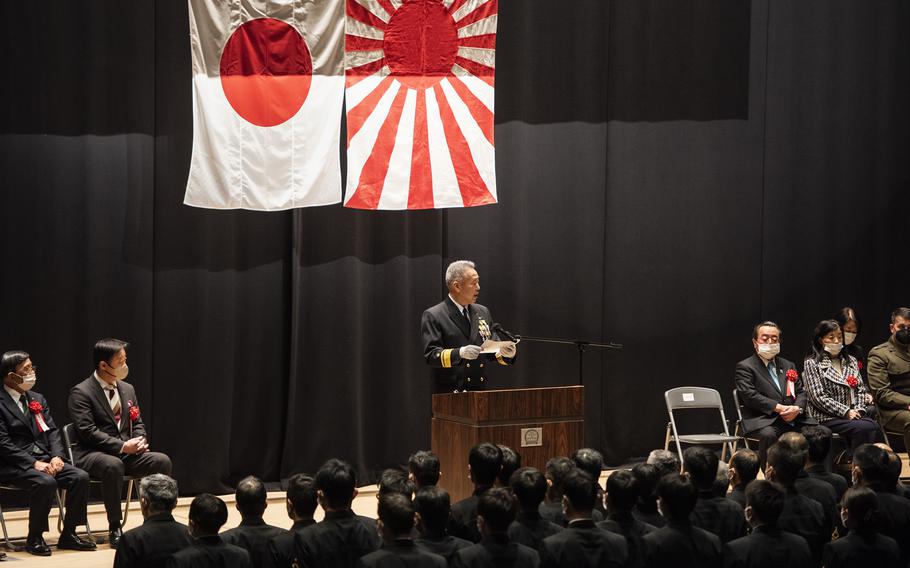
Japan Maritime Self-Defense Force Adm. Takuhiro Hiragi speaks during Fleet Air Wing 31's 50th anniversary ceremony at Marine Corps Air Station Iwakuni, Japan, March 4, 2023. (Jonathan Snyder/Stars and Stripes)
MARINE CORPS AIR STATION IWAKUNI, Japan — Fifty years have passed since Fleet Air Wing 31 of the Japan Maritime Self-Defense Force started out as a Cold War anti-submarine force.
Today the wing has a broader mission, including search and rescue, surveillance and training support. Its fleet has grown from five PS-1 flying boats to about 20 aircraft, including EP-3 and P-3 Orions and MCH 101 and CH-101 helicopters.
To mark the anniversary, wing commander Adm. Takuhiro Hiragi welcomed more than 400 guests Saturday to a commemorative ceremony at the Sakura Theater at MCAS Iwakuni, the base south of Hiroshima that the Self-Defense Force shares with the U.S. Marines and Navy.
“We have established a position as the only one unit, which cannot be replaced by other units in terms of operating systems and mission content, in the Japan Maritime Self-Defense Force aviation units,” Hiragi said during a speech.
Fleet Air Wing 31 was established as an anti-submarine, flying-boat force at Iwakuni Air Base on March 1, 1973. Since then, the wing, along with Marine Aircraft Group 12 and the Navy’s Carrier Air Wing 5, has developed a central role for the base in the U.S.-Japan alliance, “both in name and reality,” Hiragi said.
Today the air wing’s primary mission is surveillance over the waters surrounding Japan, search and rescue by its distinctive US-2 flying boats and support for anti-aircraft training by the Japanese Maritime Self-Defense Force fleet.
Mayor Yoshihiko Fukuda of Iwakuni city also spoke at the anniversary ceremony; guests included MCAS Iwakuni commander Col. Richard Rusnok and aircraft group commander Col. Derek Brannon.
“We know that the partnership between Japan and the U.S. is incredibly important in today’s world and we have been doing it for a long time,” Rusnok told Stars and Stripes at the event. “Our partnership with [Fleet Air Wing 31] couldn’t be any closer than it is today, and I’m looking forward to the next 50 years of what this partnership will bring.”
Hiragi cited the wing’s role as the security environment surrounding Japan is tested by China’s effort to change the regional status-quo by force. China has also strengthened its cooperation with Russia, which has invaded Ukraine, and heightened tensions around Taiwan by continued naval and air force activity around the island. The security climate surrounding North Korea, too, is more anxious as that country continues to test ballistic missiles, some of which crossed over or splashed down in Japanese territory.
“The Japan Maritime Self-Defense Force is fundamentally enhancing its maritime defense power with a sense of urgency and persistence,” Hiragi said, “in order to appropriately deal with various situations by deterring unilateral attempts to change the status-quo by force and challenges to the rule of law.”
Stars and Stripes reporter Hana Kusumoto contributed to this report.